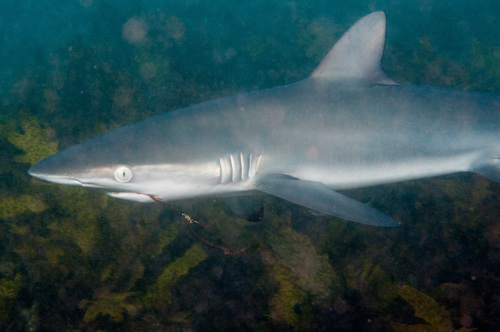
Dusky Shark
The Atlantic bluefin tuna (Thunnus thynnus) is a highly migratory, large pelagic fish renowned for its size, speed, and commercial value. It plays a crucial role in the marine ecosystem as a top predator. This magnificent species faces significant conservation challenges.
30 45 years
Lifespan
360 - 400 cm
Length
Vulnerable
Conservation Status
37 km/h
Swimming speed
Carnivorous, Scavengers
Diet
Highly Migratory, Seasonal Migration
Migration
Appearance Overview
The Atlantic bluefin tuna is a large, streamlined fish with a metallic blue body and a silvery underside.
Color
Dark metallic blue on top, silvery underside
Body Shape
Torpedo-shaped, built for speed and endurance
Fins
Two dorsal fins, the first depressible into a groove; small finlets running down the back and belly
Length
Up to 13 feet (4 meters)
Weight
Up to 2,000 lbs (907 kg)
Diet
Carnivorous, feeding on a variety of fish, squid, crustaceans, and eels.
Feeding Behavior
Highly active predator, using speed and agility to hunt. They often hunt cooperatively, herding and trapping prey.
Social Behavior
Forms large schools, especially during migration and spawning. Schools can be mixed with other tuna species.
Commercial Relevance
Extremely high value, particularly in the sushi and sashimi markets. It is one of the most expensive fish in the world.
Conservation measures
Subject to strict fishing quotas, minimum size limits, and seasonal closures. International agreements and regional fisheries management organizations (RFMOs) play a key role.
Status
Endangered (Varies by population segment; some are considered critically endangered)
Threats
Overfishing (historically the biggest threat), bycatch in fishing gear, habitat degradation, and climate change affecting prey distribution.
Habitat Distribution
Depth Range
0-1,000 meters (0-3,280 feet), but most commonly found in surface waters to 200 meters.
Geographic Range
Widely distributed across the North Atlantic Ocean, including the Mediterranean Sea and the Black Sea.
Preferred Environment
Primarily pelagic, inhabiting temperate and subtropical waters. They undertake long migrations across ocean basins.
Reproduction and Life Cycle
Breeding Habits
Spawns in warm waters, primarily in the Mediterranean Sea and the Gulf of Mexico. Spawning occurs in specific areas and times, often in large aggregations.
Development Stages
Eggs hatch into larvae, which develop rapidly. Juveniles grow quickly, eventually reaching impressive sizes as adults. The larval stage is planktonic.
Fecundity
Females are highly fecund, capable of releasing millions of eggs (up to 30 million) per spawning season.
Maturity Age
Reaches sexual maturity at around 4-8 years, though this can vary depending on the population.
Faqs about Dusky Shark
Where can Atlantic bluefin tuna be found?
Atlantic bluefin tuna are found across the Atlantic Ocean, from the eastern coast of North America to the Mediterranean Sea and the Black Sea.
How long do Atlantic bluefin tuna live?
Atlantic bluefin tuna can live for up to 40 years, though this is becoming increasingly rare due to fishing pressure.
Are Atlantic bluefin tuna warm-blooded?
Yes, Atlantic bluefin tuna are warm-blooded, allowing them to maintain a higher body temperature than the surrounding water, which aids in their swimming speed and endurance.
How fast can Atlantic bluefin tuna swim?
Atlantic bluefin tuna are among the fastest fish in the ocean, capable of reaching speeds up to 43 mph (70 km/h) in short bursts.
Why are Atlantic bluefin tuna so expensive?
The high demand for bluefin tuna in sushi and sashimi markets, combined with their slow growth and reproductive rates, has led to overfishing and significant population declines.
Copyright @ Nature Style Limited. All Rights Reserved.
 English
English